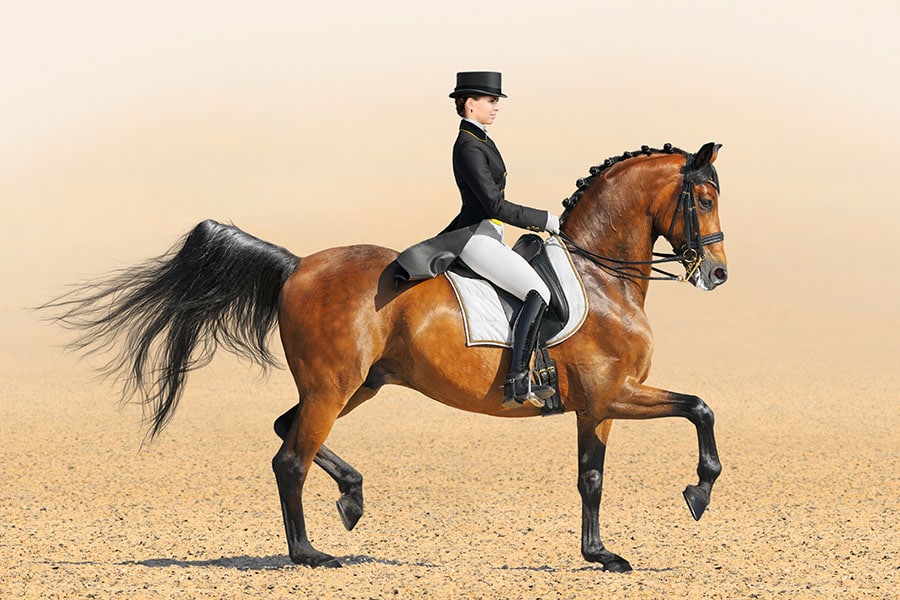As with any equine arena, having the ideal footing in a dressage arena is critical for both horse and rider performance. Installing and maintaining the proper footing can boost performance and confidence in dressage riders and their equine partners to perform to the best of their ability. Knowing what the ideal dressage footing is and the impact it has is vital for any arena owner.
What Characteristics Make a Good Footing?
The arena surface plays a big part in injury prevention, horse performance, and even how hard your horse has to work. Our team of experts and riders at Performance Footing understand the variance between arenas. They know that not all arenas should be built the same. However, there are essential traits that your arena footing should have regardless of your arena’s purpose.
- Traction. The goal of any equestrian surface is to provide the horses with enough traction to effectively grip the surface so they can move quickly and efficiently. Without sufficient traction, your horse may hesitate to take sharp turns or make quick movements. Poor traction may lead to injury as well.
- Stability. Maintaining proper stability is extremely important too. Together, traction and stability support your horse’s hooves and help their feet as they meet the footing and bounce off of it when they’re making fast movements. The base and the subsurface levels of your footing make the most significant impact on stability, making the right arena design and a great structure extremely important.
- Cushioning. Another critical element is cushioning. Without proper padding under their hooves, your horses could easily injure themselves. A surface that is too hard could also scare them, preventing them from performing their best. A surface that is too soft may inhibit their performance and cause soft tissue injuries.
- Retains moisture. Keeping your arena footing moist will help with stability and is partially dependent on your footing composition and the way it interacts with water. If you neglect to water your arena, this will also impact your arena surface.
- Dust Free. The ideal arena is dust-free, as it is hazardous to the health of humans and horses. Even when horses are trotting back and forth across the footing, you should aim to reduce dust as much as possible. If you live in a hot, dry area, it is easier to keep indoor arenas dust free. If you live in an area where it rains often, an outdoor arena is an easier option for preventing dust problems.
It is essential to point out that effective footing results from careful planning and consistent maintenance. You must frequently water, drag, and re-evaluate your arena’s composition to ensure the highest quality.
Building an equine arena is a long-term investment that also requires daily maintenance to ensure the best result. If you feel that your maintenance efforts aren’t working, consider working with an equine arena consultation service.
What Materials Should I Use for My Dressage Arena?
Horse arena footing composition is a science. There are an array of variables that may affect what materials you choose, such as raw material availability, whether your arena is indoor or outdoor, the climate, and whether you want to use additives. The following materials are common materials that almost every arena uses, especially dressage arenas.
Sand
The most common primary footing material for a dressage arena — and really any indoor or outdoor arena — is sand. Because it is so affordable, arena owners can keep costs low by integrating sand in their arena footing. There are also many different options available regarding the type of sand, depending on your intended use.
Rubber Mulch
Rubber footing is sometimes mixed with sand for arena owners that do not have high-quality soil present. One of the downfalls of rubber mulch is it can become slick when wet and retains heat. Depending on your geography, it may even harden. Your location and climate should be considered when choosing a rubber mulch.
For those with a strict budget, rubber mulch may not be suitable. Since it is a synthetic material, it is usually more expensive than natural options.
Additives
In addition to these sand and rubber mulch materials, our footing experts recommend incorporating additive materials to improve the composition of your arena surface. There are a wide variety of footing additives that serve different purposes. Additives may be useful if you need help retaining moisture, binding materials together, and suppressing dust.
These materials range in terms of their composition, as some — such as salt — are organic, while others are synthetic. A common additive type is a rubber mixture, which can either replace or supplement high-quality soil.
What Does Performance Footing Offer?
At Performance Footing, we offer four dressage arena footing products that can improve your arena, whether you are starting from scratch or making changes to your current arena. Our FoamFooting is the ideal additive for any arena, especially dressage arenas.
As a team of riders, trainers, and product designers, we created FoamFooting to improve footing for various disciplines. Regardless of which base and footing materials you have, our FoamFooting comes with a variety of benefits:
- Softens the impact on hooves
- Lessens the amount of dust
- Reduces the amount of watering
- Improves cushioning
- Enables longer training sessions
- Less frequent injuries
- Happier horses
Dust Halt is also a great additive to consider if you have trouble keeping dust at bay in your arena. Not only is it eco-friendly, but it requires low maintenance and is long-lasting too.
If you are interested in upgrading your arena footing or are building for the first time, talk to our team today to get your order started!
